Diversity of Canada’s Marine Coastal Habitats
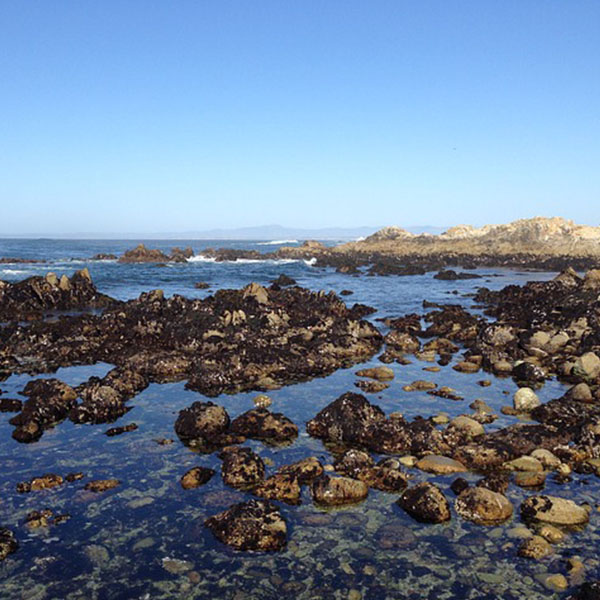
Tidepool (Bayscholar, Pixabay)

Tidepool (Bayscholar, Pixabay)
How does this align with my curriculum?
Learn about the plants and animals in Canada’s marine coastal habitats, and what you can do to protect them.
Marine are habitats found along the coasts of the world’s continents.
Did you know?
Worldwide, there are more than 350 000 kilometres of coastline. More than half of that (202 080 km) is Canadian!
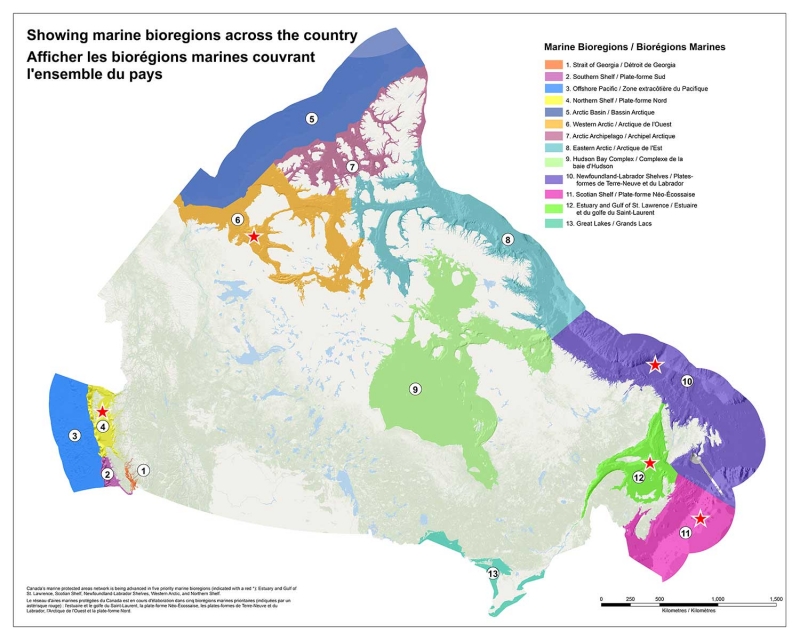
Image - Text Version
Shown is a map of Canada with marine bioregions indicated by different colours along the coasts. The east coast of Canada is made up of the Scotian Shelf and Newfoundland-Labrador Shelves as well as the Estuary and Gulf of St. Lawrence which reaches inland. The interior contains the Hudson Bay Complex and the Great Lakes bioregions. The northern coast of Canada is made up of the Eastern Arctic, Western Arctic, Arctic Archipelago, and the Arctic Basin bioregions. The west coast is made up of the Northern Shelf, Strait of Georgia, Southern Shelf, and Offshore Pacific bioregions.
Coastal marine habitats are some of the most dynamic habitats on Earth. They are constantly changing because of waves, tides, and from land. Because of their close connection to land, they are also very sensitive habitats that can be easily impacted by humans.
There are many different types of coastal marine habitats in the world. In this backgrounder, we will look at the most common types worldwide. We will look at where they are found, what plants and animals live in them, and how they are impacted by climate change.
Intertidal Zones
Let’s start with the hardest to classify because it is as much an as it is a living on land habitat. are habitats that are below the surface of the ocean at high tide and above the surface of the ocean at low tide. Because of this, the animals that live there are . This means that they can live on land and in water. In rocky intertidal zones, can also form. These provide temporary pools for marine animals such as sea stars, anemones and urchins.
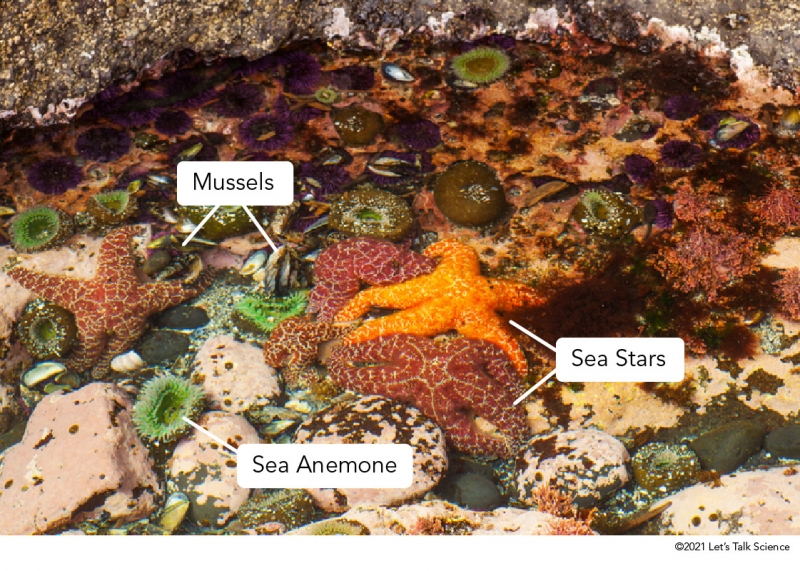
Image - Text Version
Shown is a colour photograph of a tidal pool. In among the pale beige rocks are several different types of invertebrate animals including pale green sea anemones with their tentacles outstretched, dark blue mussels, and red and orange bumpy sea stars.
Temperature changes in the ocean as a whole takes time. But in the intertidal zones, temperatures can change fairly quickly. This is why being able to adapt to various temperatures is important for animals living in the intertidal zone. This is especially important in warm, tropical climates. Scientists have found that intertidal snails can completely shut down when the water they live in gets too hot.
Common intertidal animals include crabs, limpets, chitons and barnacles. All these animals have . These external shells help them from drying out during low tide. Crabs, like other crustaceans living in intertidal areas, can move. This allows them to find food, escape predators and avoid crashing waves.

Image - Text Version
Shown are three images of animals that are found in intertidal zones-limpets, barnacles, and a chiton. The image on the left shows a group of limpets. The limpets are small shells stuck to a rock. Their shells are shades of brown and tan with hints of red. The shells are striped with concentric circles of different colours. The middle image shows a pair of barnacles stuck to a rock. The barnacles are tan and conical-shaped with an opening at the top. Many small finger like tendrils grip the rock at the bottom of the barnacle. The image on the right shows a chiton stuck to a rock. The chiton is dark brown, cylindrical, and slimy. It has about eight small tan circles in a line across it's surface.
Limpets
Limpets may not seem like they move, but they can. Only very slowly! Like other , limpets on algae that grows on rocks and other surfaces. Like snails, they suction themselves to surfaces using a very strong muscular “foot”.
Barnacles
Barnacles are animals. This means that they don’t go anywhere. First they attach themselves to a surface, such as a rock or a pier. Then they stay put for the rest of their lives! Barnacles “close off” at low tide and open up at high tide.
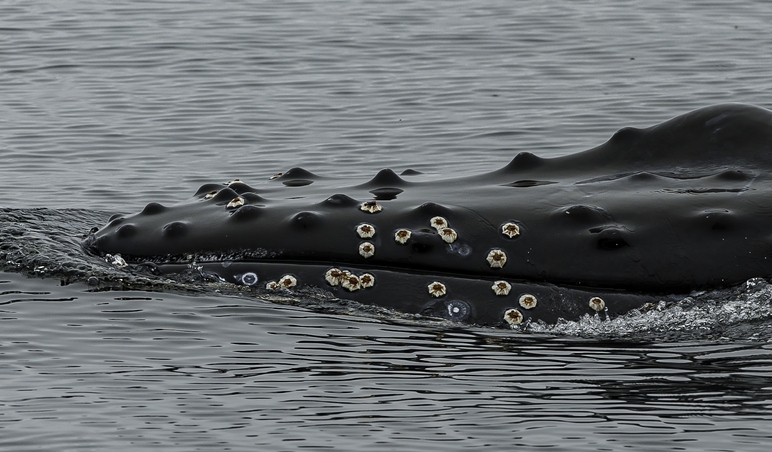
Image - Text Version
Shown are barnacles on the skin of a Humpback whale. The whale's head is shown surfacing in the water. The whale's head is black and shiny with about a dozen bumps. About ten barnacles are clinging to the whale's head. The barnacles are circular with a white ring around a red center. There are also scars from previous barnacle attachments. These are pale blue and white concentric circles.
You may have seen photos of lumps on whales. These were likely barnacles! It is thought that whales breach to get rid of these unwanted hitchhikers. Scientists are even looking at how a barnacle’s super sticky could be used for human surgeries!
Chitons
There are more than 900 species of chitons found throughout the world. All live in the intertidal zone. Chitons have a segmented shell and a foot like a snail. Unlike limpets and snails, some chitons are and some are .
Sandy Beaches
Mudflats are another type of intertidal zone. They look similar to sandy beaches but differ in having muddy, -rich soil. This makes them an ideal place for many species.
Finally, intertidal habitats often welcome some more adventurous typically marine or terrestrial animals too, such as this octopus hunting in a tidal pool!
Now, let’s dive into the fully aquatic habitats.
Rocky and Sandy Underwater Habitats
Underwater shallow coastal habitats are very much like the intertidal zone. The animals here still need to be able to withstand waves and tides. However, they don’t need to be able to survive dry periods. In underwater sandy areas, you’ll find a variety of burrowing animals. You will also find their predators, such as sea stars. Rocky areas offer a great variety of hiding spots. This is ideal for young fish and sessile animals that need to hide from their predators.
Estuaries
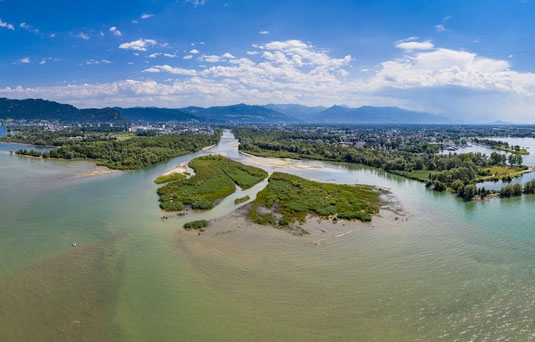
Image - Text Version
Shown is an aerial view of an estuary. A river is emptying into a larger body of water. The river channel can be seen in the distance. Green islands and thin peninsulas are shown where the river meets the larger body of water. The water is light blue. Tan sediment is visible in the water in several locations, especially close to the land.
For the species that can tolerate the variations in salt, estuaries offer plenty of food. It is considered the most productive aquatic habitat. This is because of the high levels of nutrients coming from surface runoff. Surface runoff also makes those habitats prone to pollution from land.
Many marine species also take advantage of this habitat as a . Young fish and other animals often have a hard time surviving in the open ocean. Estuaries provide a safer place to develop into adulthood.
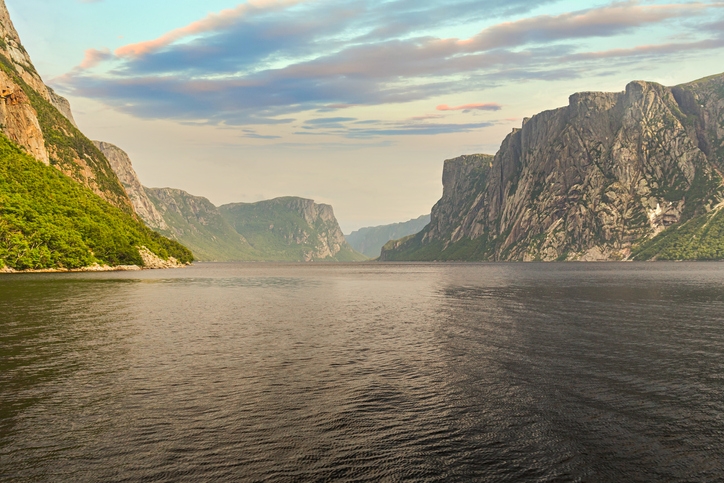
Image - Text Version
Shown is a view from a tour boat at the fjords of the Western brook pond in Gros Morne National Park, Newfoundland and Labrador. A large body of water is surrounded by tall cliffs on both sides. The cliffs are primarily made of tan rock with some green trees and vegetation. The sky is blue with wisps of purple clouds.
Salt Marshes
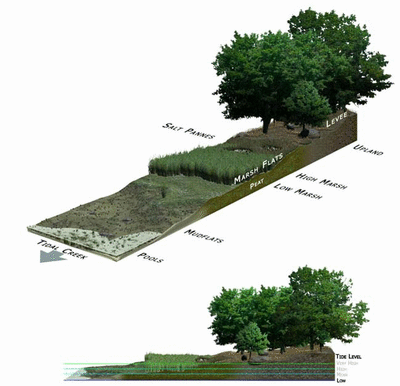
Animation of a salt marsh as the tide comes in (Source: Public domain image by the National Oceanic and Atmospheric Administration via Wikimedia Commons).
Image - Text Version
Shown is an animation of a salt marsh as the tide comes in from two different perspectives. Both show how the rising tide impacts various zones of a salt marsh. As the water rises, it first fills the pools and mudflats which have a brown, textured appearance. It then rises up to the low marsh which is made up of marsh flats which are vegetation on top of a layer of peat. The water finally reaches the high marsh. It stops right before flooding the trees that are located at the upland zone on a levee.
To live in salt marsh, plants must be able to tolerate high levels of salt. Plants that are able to do this are known as . The word “halophyte” comes from the ancient Greek words Halo meaning “salt” and phyto meaning “plants”. Most normal plants would die in those conditions, but halophytes have some special adaptations. Some halophytes have found ways to prevent the absorption of salts through their roots. Others can salt through their leaves. Others have special salt glands to excrete salt.
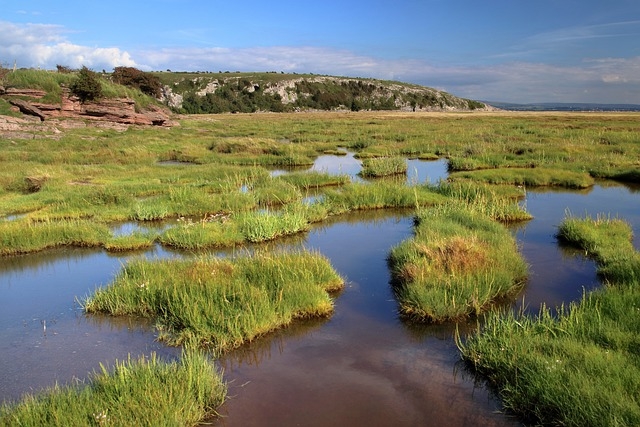
Image -Text Version
Shown is a colour photograph of an aerial view of a salt marsh. The foreground of the image is made up of large patches of yellow/green grasses surrounded by dark water that is reflecting the blue of the sky. In the background, a small hill rises above the salt marsh. The hill is covered in grasses and dark green trees. A thin beach of tan sand sits between the hill and the marsh.
Salt marshes also act as biological filters. This prevents some from reaching the ocean. For example, they can prevent coastal eutrophication caused by nitrogen in surface runoff. Like freshwater marshes, the of salt marshes had long been misunderstood. But now scientists better understand their role, which has allowed many areas to now be protected.
Seagrass Meadows
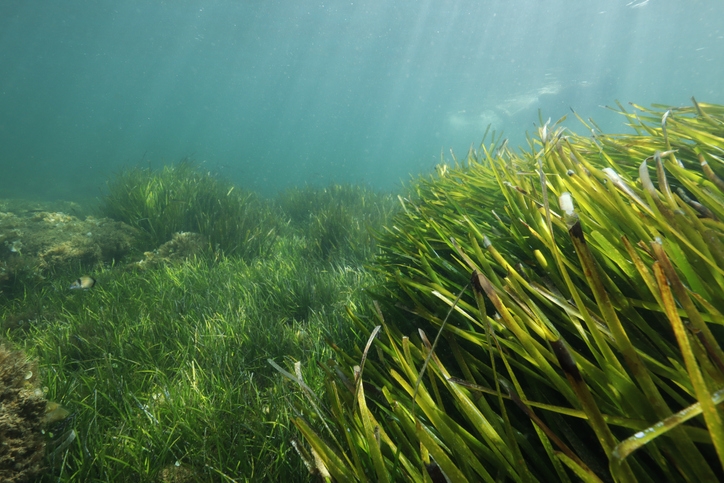
Image - Text Version
Shown is a colour photograph of a seagrass meadow. The lower part of the image looks like a grassy field, but the upper part of the image is clearly pale blue water. Streams of sunlight highlight and shade the grasses.
Did you know?
Marine grass, such as eelgrass, can grow up to 2 metres long.
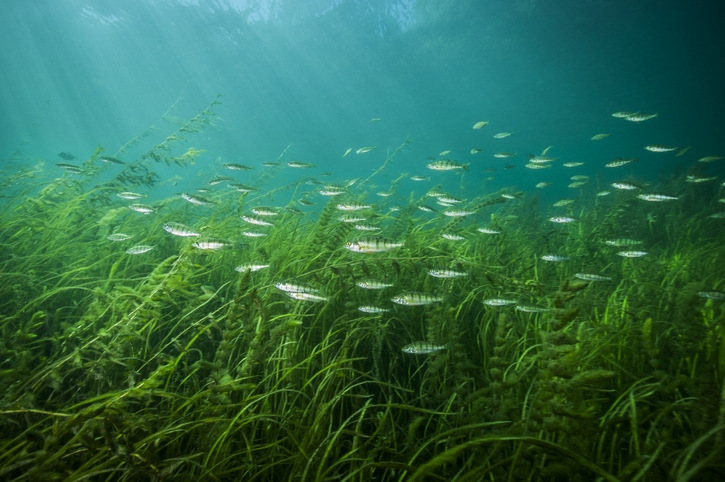
Image - Text Version
Shown is a colour photograph of a seagrass meadow. The lower part of the image looks like a grassy field, but the upper part of the image is clearly pale blue water. A large school of silver and black striped fish swim towards the left.
When the Atlantic cod populations collapsed in 1993, more than 35 000 workers lost their jobs and way of life in the Canadian maritimes.This dramatic decline pushed more scientists to research the effect of fisheries on marine ecosystems. As a result, people came to better understand the life cycle of fish and their needs. For cod, this included protecting the seagrass meadows. This also involved reviewing other fishing methods, such as , that can destroy seagrass meadows.
Kelp forests
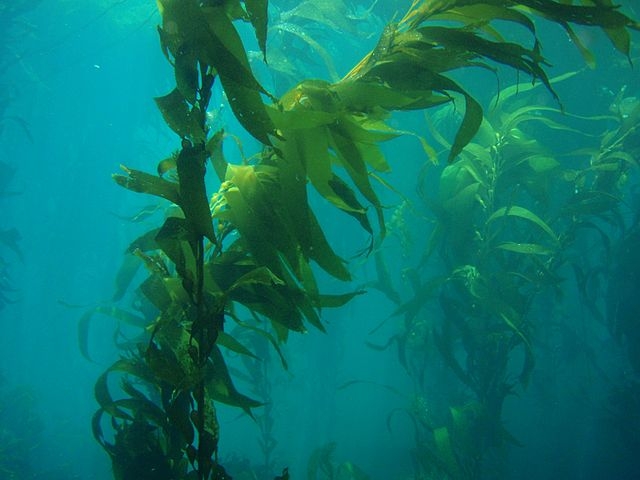
Image -Text Version
Shown is a colour photograph of giant kelp in the ocean. A long green stalk stretches up through teal water. The stalk is covered with long leaves pointing towards the right, like flags blowing in the wind. More stalks of kelp are visible in the background.
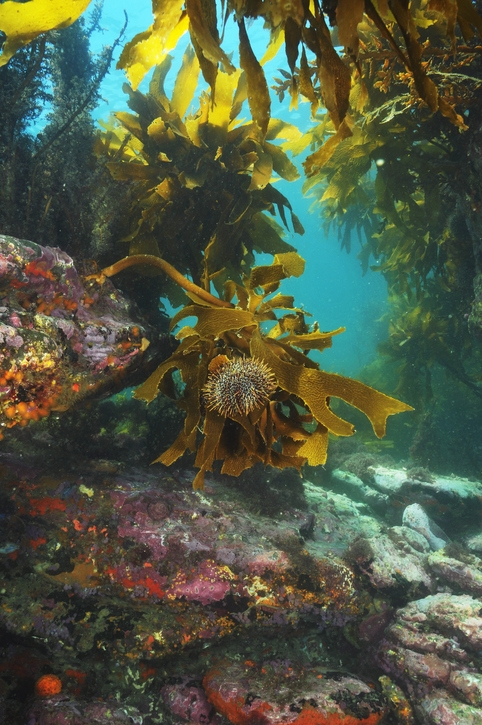
Image -Text Version
Shown is a colour photograph of a sea urchin on a kelp plant. The water is teal in this underwater scene. The narrow leaves of yellow brown kelp stretch across the top, center, and right side of this image. A sea urchin is stuck to the kelp in the middle of the image. It is circular and dark brown with many light coloured spikes on it. The bottom and left side of the image is made up of grey rock with a variety of colorful algae stuck to it.
Sea urchins are not the only animals that eat kelp. Humans also harvest kelp for commercial uses. This includes putting kelp into food for animals and extracting algin from kelp to use in foods and cosmetics.
People are now beginning to realize how important kelp forests are for reducing impacts. This is because kelp forests are great carbon sinks.This means that they capture more carbon matter than they create. However, this is not only true for kelp forests. Seagrass meadows and salt marshes are also important carbon sinks.
Did you know?
is the term used for the carbon captured by the world's ocean and coastal ecosystems.
Coastal Habitat Conservation
This backgrounder was really just a quick introduction into the amazing plants and animals that live in coastal marine habitats. But there are many more living things we didn’t even touch upon. For example, we didn't even mention all of the shorebirds that rely on oceanic resources.
We encourage you to learn more about the habitats close to your community - both terrestrial and aquatic. If you live near a coast, there are ways you can help. You can be a citizen scientist and report species sightings, such as the capelin of the maritimes. Or you can participate in a shore cleanup.
Coastal habitats are home to a huge number of living things, but human activities put increasing pressures on these sensitive habitats. If we don’t protect them, one day, they will be gone!
Learn More
Canada’s Marine Coasts in a Changing Climate (2016)
This report from the Canadian Government presents information on the status and conservation efforts on coastal habitats.
Organisms Beneath the Sand
This page with video (2:24 min) from the Smithsonian presents a short video of life among grains of sand.
Estuaries
This page by Hinterland Who’s Who gives information on characteristics of estuaries in Canada.
Ocean Data Viewer
This interactive map page by UNEP presents where different oceanic and coastal habitats are found.
Salt marshes
This article from Current Biology presents the characteristics of salt marshes.
Explore the underwater corridors of kelp forests (2019)
This video (0:51 min) from Oceana shows what life looks like in the kelp forests.
References
Encounter Edu (n.d.). Learn more: What are marine habitats? Retrieved from https://encounteredu.com/cpd/subject-updates/learn-more-what-are-marine-habitats
Flanders Marine Institute (n.d.). Coastal Wiki. Retrieved from http://www.coastalwiki.org/wiki/Main_Page
Marine Habitats: Coastal (Dec. 6, 2021). Wikipedia. Retrieved from https://en.wikipedia.org/wiki/Marine_habitats#Coastal
MooMooMath and Science (Aug. 15, 2017). What is an estuary? [Video]. YouTube. https://www.youtube.com/watch?v=emVVYG7dSaA
The World Factbook (n.d.) Geography. Retrieved from https://www.cia.gov/the-world-factbook/countries/world/#geography
UN Environment Programme World Conservation Monitoring Centre (2021). Ocean Data Viewer. Retrieved from https://data.unep-wcmc.org/
Zedler, J.B. (2015). Salt Marsh Secrets: Who uncovered them and how? Tijuana River National Estuarine Research Reserve. Imperial Beach, California (http://trnerr.org/SaltMarshSecrets).